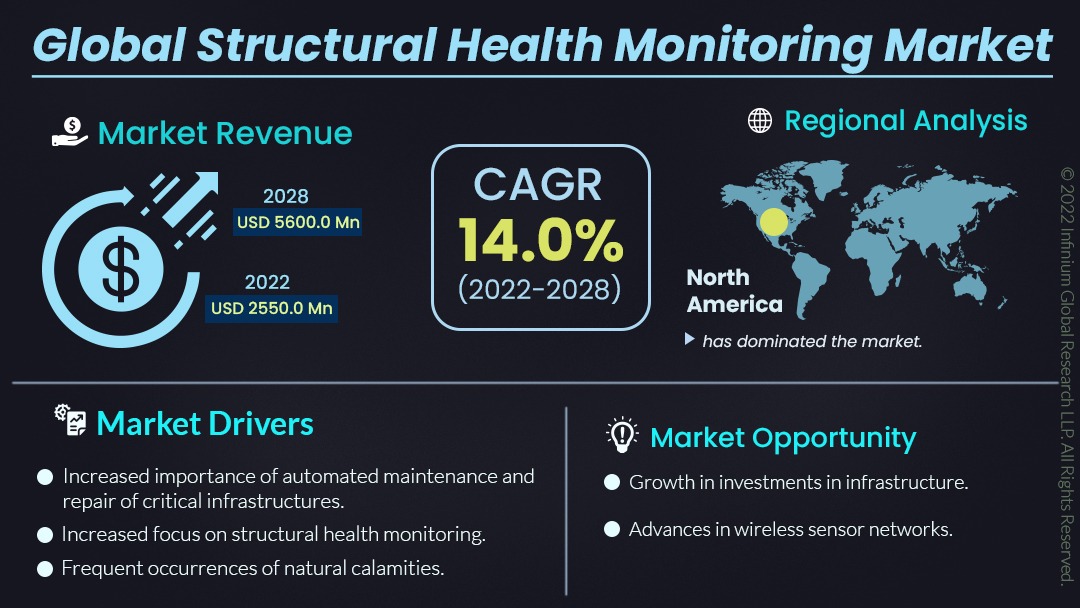Structural Health Monitoring Market (Component - Hardware, Software, and Services; Technology - Wired, and Wireless; End User - Aerospace & Defence, Civil Infrastructure, Mining, Energy, and Others): Global Industry Analysis, Trends, Size, Share and Forecasts to 2028
A recent report published by Infinium Global Research on the structural health monitoring market provides an in-depth analysis of segments and sub-segments in the global as well as regional structural health monitoring market. The study also highlights the impact of drivers, restraints, and macro indicators on the global and regional structural health monitoring market over the short term as well as the long term. The report is a comprehensive presentation of trends, forecasts, and dollar values of the global structural health monitoring market. According to the report, the global structural health monitoring market is projected to grow at a CAGR of over 14% over the forecast period of 2022-2028.
Market Insight
The revenue generated by the structural
health monitoring market was over USD 2550 million in 2022 and is expected to
reach about USD 5600 million in 2028 and is expected to grow with a CAGR of
over 14% over the forecast period 2022-2028. The process of monitoring changes
in the material and geometric qualities of engineering structures is known as
Structural health monitoring (SHM). These geometric structures like bridges and
buildings are monitored over time using periodically sampled response
measurements. Structural health monitoring gives regularly updated information
regarding the ability of the system to perform its intended function in light
of the inevitable aging and degradation obtained from operational environments
for long-term structural health monitoring. Structural health monitoring is
handy after extreme earthquakes or blast loading. Furthermore, this process is
used for rapid condition screening and aims to provide, in near real-time,
reliable information regarding the integrity of the structure. The customers
who use the structural health monitoring process benefit from forecasting and
measuring profits, Integrating and augmenting systems, tracking and measuring
construction activities, managing risk portfolios, boosting revenue and
enhancing productivity, enabling remote operations, reducing manual
interactions, automating decisions, and others. The structural health
monitoring process simplifies communications between the system and the
operators; hence, it is a helping process for laborers to enhance productivity
and optimize cost and operations.

Due to the outbreak of the COVID-19 pandemic, the structural health monitoring market had witnessed a downturn. In 2020, the major construction, maintenance, and repair activities in the civil infrastructure, aerospace & defense, and energy sectors across various countries were stopped. These caused a decrease in the demand for monitoring devices and services. Also, during the pandemic, the companies in the structural health monitoring market have witnessed many losses due to supply chain disruptions. However, in 2021, the market has shown gradual recovery because governments are resuming infrastructure development work to reduce the unemployment rate caused by the COVID-19 pandemic.
The increased importance of automated maintenance and repair of critical infrastructures are the prime factors propelling the growth of the structural health monitoring market. Furthermore, the other factors driving the development of the market are increased focus on structural health monitoring, obsolete infrastructure in Europe and North America, obsolete aircraft of domestic & international airlines, reduction of inspection costs, and frequent occurrences of natural calamities. On the other hand, high installation and monitoring costs due to an increase in range, resolution, repeatability, precision, and accuracy are hampering the market's growth during the forecast period. Furthermore, there are many challenges related to data normalization, limiting the market growth. Nevertheless, an increase in investments in infrastructure and advances in wireless sensor networks is creating exponential opportunities for the market during the forecast period.
North America has dominated the structural health monitoring market by holding the largest revenue share in 2021. Due to the rising focus of the government on the repair and maintenance of the civil infrastructure, there is a massive demand for the structural health monitoring market in the region; hence North America is expected to dominate the market during the forecast period further. Furthermore, the other factors driving the market’s growth in the North American region are aging infrastructure and increasing investments from various governments in the area. Additionally, countries like the US and Canada are using structural health monitoring systems to ensure the safety and security of structures and people. For instance, in 2020, the US government announced a USD 2-trillion plan to upgrade the country’s infrastructure, including roads and bridges.
Segment Covered
The report on the global structural health monitoring market covers segments such as component, technology, and end user. On the basis of component, the sub-markets include hardware, software, and services. On the basis of technology, the sub-markets include wired, and wireless. On the basis of end user, the sub-markets include aerospace & defense, civil infrastructure, mining, energy, and others.
Companies Profiled:
The report provides profiles of the companies in the market such as COWI (Denmark), Campbell Scientific (US), Geokon (US), Nova Metrix LLC (US), SGS (Switzerland), Acellent Technologies, Sixense, Pure Technologies, Structural Monitoring Systems, and Geocomp.
Report Highlights:
The report provides deep insights
into demand forecasts, market trends, and micro and macro indicators. In
addition, this report provides insights into the factors that are driving and
restraining the growth in this market. Moreover, The IGR-Growth Matrix analysis
given in the report brings insight into the investment areas that existing
or new market players can consider. The report provides insights into the
market using analytical tools such as Porter's five forces analysis and DRO
analysis of the structural health monitoring market. Moreover, the study highlights
current market trends and provides forecasts from 2022-2028. We also have
highlighted future trends in the market that will affect the demand during the
forecast period. Moreover, the competitive analysis given in each regional
market brings insight into the market share of the leading players.
